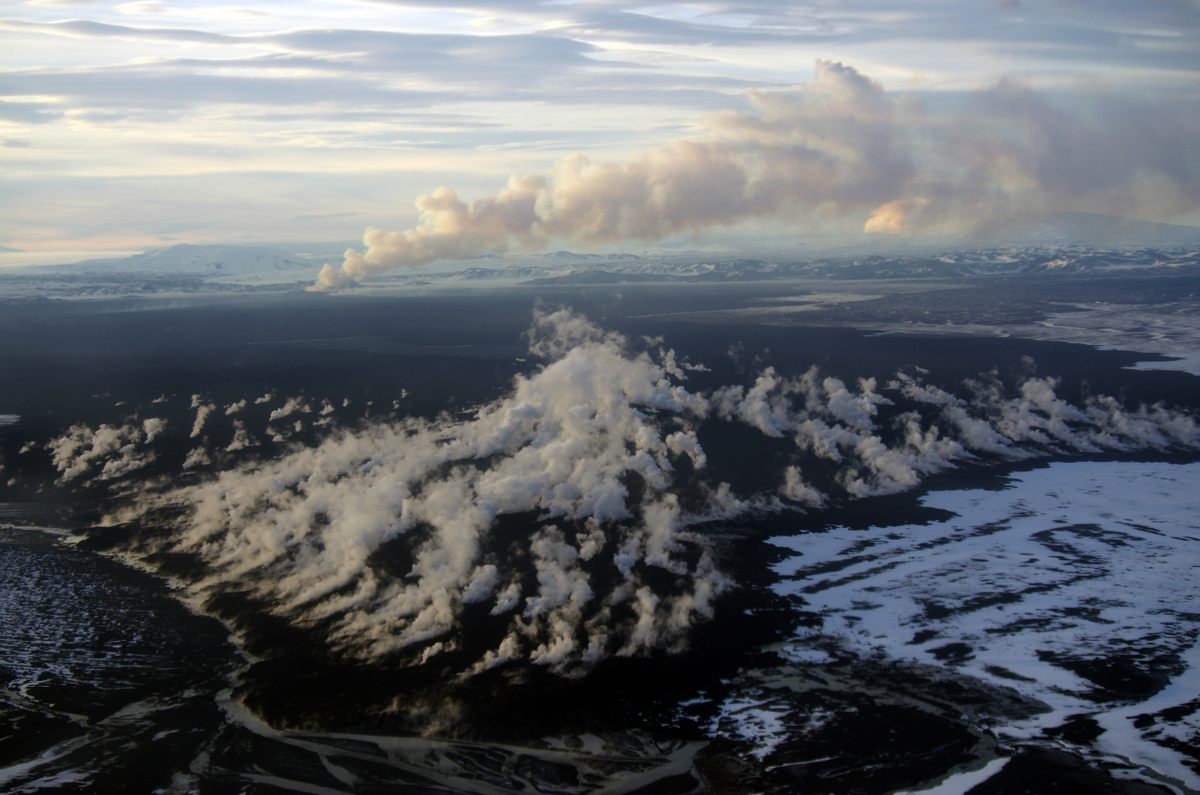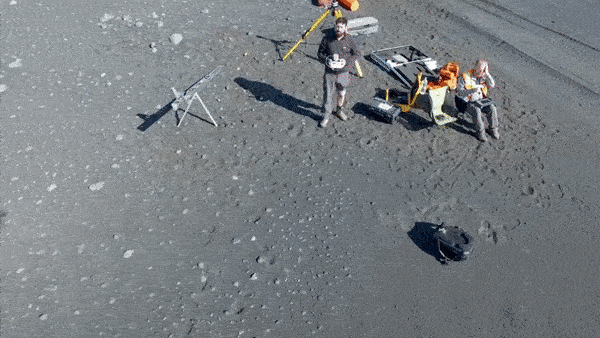In Iceland, Testing the Drones That Could Be the Future of Mars Exploration
“We’re going to do so many cool things.”
On February 18, 2021, if all goes to plan, NASA’s Perseverance rover will land on Mars. While it’s poking around, looking for signs of past habitability, Ingenuity—a tiny, experimental solar-powered helicopter hitching a ride on its underside—will try to demonstrate the possibility of flight on another world for the very first time. We may be looking at the future of exploration on the Red Planet.
Back here on Earth, others are already looking beyond Ingenuity. A next-generation NASA-funded Mars mission concept, the Rover-Aerial Vehicle Exploration Network or RAVEN, is about to be put through its paces in a gauntlet like no other. The project will pair an autonomous rover with specialized drones and be sent across a 32-square-mile lava field in Iceland as a test run for a future on Mars.
Interplanetary rovers are technological marvels, but they’re stuck to the ground. Drones, in one form or another, are the next evolutionary step, and they will be used for more than just reconnaissance. With scoops and drills, eventually they will “go somewhere the rover can’t go, and bring something back,” says Christopher Hamilton, a planetary scientist at the University of Arizona and lead researcher on RAVEN.

There’s no mistaking the impact drones are having on science right now. During the prolific eruption of Hawai‘i’s Kīlauea volcano in 2018, the government authorized the largest peaceful deployment of drones in American history. Spearheaded by longtime drone advocate Angie Diefenbach, a geologist at the U.S. Geological Survey’s Cascades Volcano Observatory, they were used to film lava fountains up close, track the slithering progression of molten rock, and even help people escape their homes in the dead of night.
Today, the U.S. Geological Survey has a dedicated drone program, catching up with universities across the world that are using them to reach inaccessible or dangerous places for scientific research. “It’s the age of the drones,” says Diefenbach. “We’re going to do so many cool things.”
Not long ago, the most advanced drones “were all in the hands of the military,” says Gordon Osinski, a planetary scientist at the University of Western Ontario and RAVEN team member. Now you can buy pretty capable ones online or at your local computer store. Bit by bit, he says, drones “are changing how we do fieldwork on Earth. And I think it’s definitely going to do the same for other planets.”

Scientists are getting very good at piloting drones down here, but flying on Mars is going to be tougher. The air density is a fraction of Earth’s, so any mechanical aviators will need to push a lot more of it to get any elevation—hence Ingenuity’s test run. While engineers grappled with this challenge at NASA’s Jet Propulsion Laboratory back in 2014, the Bárðarbunga volcanic system in Iceland erupted. Between August 2014 and February 2015, it spilled enough lava to easily smother Manhattan, making it Iceland’s largest eruption in 230 years.
The lava flow, as it cooked ice and water trapped below, developed a hydrothermal system with hot springs that became home to many happy microbes. By 2021, things had cooled, but vestiges of those bastions of life still exist, creating an environment similar to what researchers hope to be able to identify on Mars. To the tune of $3.1 million, NASA agreed with Hamilton that it would be a great place to test the next generation of automated Mars explorers, and RAVEN was born.
There are two components to RAVEN. The first is the rover. Courtesy of the Canadian Space Agency, it’s comparable to Curiosity in capability and design. It can be remotely operated by a human, (on Mars there would be several minutes of delay between commands and action) but it’s also able to navigate the land all on its own.

The real innovation of the project will be in its cargo. The drone is a carbon fiber hexacopter, capable of flying for around 35 minutes and up to a distance of three miles, carrying about 20 pounds of scientific equipment. It will act as the more technologically capable rover’s field assistant.
A camera will be one key instrument, but for more than just aerial photographs. It can take several different photographs of the same surface feature, and then send them to the rover, where heftier processors will make true 3D maps of terrain—“a full virtual rendering of the environment around the drone and rover,” says Hamilton. These, in turn, will help it navigate precisely and speedily around the area.
The drone will also use a visible to near-infrared spectrometer, which looks at radiation coming off the ground to identify any interesting minerals or substances. But the drone has another killer app.
NASA is laser-focused on bringing pristine Mars rocks back to Earth. Perseverance will dig up and cache 43 pen-sized rock samples that, through a series of upcoming NASA and European Space Agency missions, will be brought to Earth by 2031. While this robotic Rube Goldberg machine plays out, RAVEN will be testing a new way to grab samples in Iceland.
“My favorite part of RAVEN is the Claw,” says Hamilton. This refers to a scoop, or a series of scoop designs, that will be attached to the drone. Rocks of interest will be picked up and flown back to the rover, where the rover’s chemical-interrogating technology will see if the rock is fascinating enough to go visit the site where it came from, either to see the original context or get a bigger sample.
Scientists are looking to use that same concept for their Earthbound drones too. “The most exciting bit was to see the Claw attached to it, because that’s exactly where I’d like to go in the next year, for the [U.S. Geological Survey] at least,” says Diefenbach, for applications here. “That made me pretty excited.”
The team’s engineering partner, Honeybee Robotics, is coming up with drill designs, too, to pull out small cylindrical cores or grind rock into powder that can be vacuumed up and flown to the rover.

This year, RAVEN’s hardware is being manufactured and software is being coded while its hardware is manufactured. The games will begin in summer 2022, when the rover and drones arrive at Bárðarbunga volcano’s Holuhraun Lava Field.
The actual first test of the equipment reads like the instructions of a practical final exam. An operations team unfamiliar with the site, which will include students, will use satellite imagery to determine where best to “land” the rover and drones. They will issue commands to both vehicles and, within a set amount of time measured in Mars-days, then characterize the environment’s geology and identify potentially habitable or once-habitable pockets of it. In addition to testing RAVEN’s technology, the test will determine if a team new to the site will be able to identify the most astrobiologically areas to study—just as a future rover-drone Mars mission will have to. “I can’t participate in the science planning for our team, because I have the answer key,” Hamilton says, since he already knows the site, and the areas with the best potential for exploration. After the trial ends, and the team compares notes, they’ll run it back in summer 2023.
Hamilton can picture the time where RAVEN, or something like it, is deployed on Mars for real. By that stage, he says, “there is the possibility that the rover would be an astronaut.” Imagine that, not science fiction but real: spacefaring scientists, flying drones over Martian volcanoes, searching for alien biosignatures in the hazy light of the distant sun, the Earth (and Iceland’s lava fields) a bluish dot in the sky.














Follow us on Twitter to get the latest on the world's hidden wonders.
Like us on Facebook to get the latest on the world's hidden wonders.
Follow us on Twitter Like us on Facebook